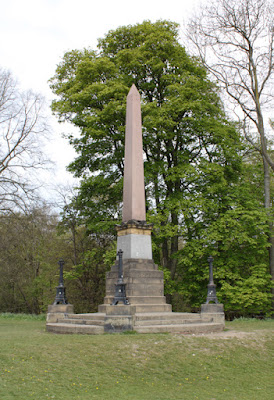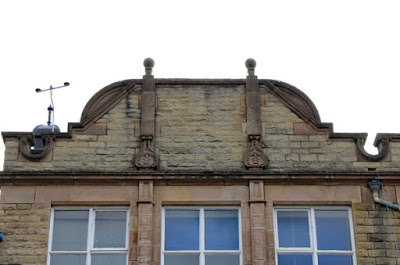 |
| An inscribed gate pier at Hunters Bar Board School |
Returning to Ecclesall Road after my brief look at the former Greystones Council School, after passing various early C20 commercial premises of no great architectural merit, I took a diversion to Endcliffe Park to photograph the Jubilee Obelisk for the British Listed Buildings website.
I then continued to Hunters Bar, where the former Hunters Bar Board School was the next building on my itinerary to visit. Although not listed, having recently purchased the book Building Schools for Sheffield, published by the Victorian Society, I had made it my intention to try and visit all of these during the months ahead.
Originally built in 1893 for 360 pupils to the design of CJ Innocent, who had been practising on his own since the death of his partner Thomas Brown in 1881, it was extended 1906-07 by AF Watson to provide a further 760 places, which reflected a rapid growth of terraced housing in the area during the first decade of the C20.
With the school surrounded by high stone walls on all sides, I could only get a few good views of the school from a distance and, with the masonry being dirty, the colour and texture of the sandstone were largely obscured.
Compared to most of the other Sheffield Board Schools by Innocent and Brown that I have seen to date, it appears very utilitarian and contrasts greatly with the now demolished Newhall Board School, which he had designed 20 years earlier.
Only the central tower, with a pyramidal roof, weathervane and decorative fake machicolations give it any real character and Watson’s extension is very austere, perhaps reflecting the fact that Sheffield City Council was by now responsible for commissioning new schools.
Although the rock-faced masonry is in places built with blocks of a greater bed height, I couldn’t see anything that made me think that that there had been any changes to the favoured choice of Crawshaw Sandstone for the walling, although the massive stone for the dressings could be any one of the better stones from the Millstone Grit of Derbyshire or West Yorkshire.
Ornament is virtually absent, with the inscribed gate piers - where the raised lettering is set in a recessed panel in the form of a broken pediment – and the Sheffield School Board initials, beneath a carved shell, being the only decorative elements that I noticed.
Having taken a few general record photographs, I then continued down Ecclesall Road to find the former Pomona Street Board School, built in 1900 to a design by Holmes and Watson, but which is set back behind a high wall and mesh fence and not easy to view closely.
It is apparently described in the Pevsner Sheffield City Guide as having ‘strangely Mannerist-shaped parapets’ bearing ball finials, and ‘buttresses that turn into pilasters above the ground floor’; however, I was more interested in the massive sandstone used for the dressings, which is slightly pink in colour and unlike any stone that I had previously seen used in the schools.










No comments:
Post a Comment